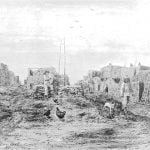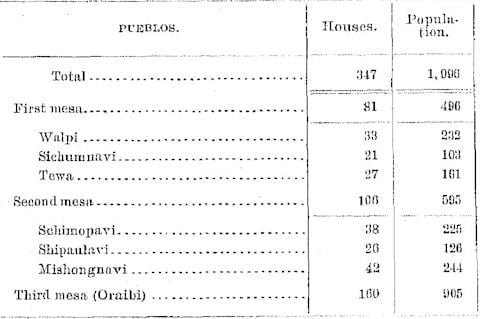The statistics of the population, wealth and social condition of the Moqui Pueblos show that, although isolated from the Anglo-Saxon, the Moqui Pueblo is amply able to care for himself if aided merely by an issue of those things which will multiply in the future to his advantage.
The enumeration was made by Francis M. Zuck, under the direction of E.S. Clark, supervisor of census for Arizona, as a special census, and the numbers are not included in the general census. The statistics of property and values were secured by Julian Scott, special agent, and the special agent in charge.
The population of the 7 Moqui pueblos in 1890 was 1,996; males 999; females 997; over 18 years of age, 1,118; under 6 years of age, 288; over 5 years of age and to 18 inclusive, 590; heads of families, 364; house owners, 364; farmers and weavers, 456; day laborers, 6; medicine men, 2; pottery makers, 366; governors, 7. One thousand seven hundred and forty-nine speak nothing but the Indian language’ 6 speak Spanish, 51 speak English, 33 read it, and 25 write English. This does not include the 44 children at the United States Indian boarding school at Keams Canyon. The Indians noted as writing Indian are able to represent Indian words with the Roman letters.
All the Indians wear Indian clothing. The oldest man is 96 years and the oldest woman is 94 years of age. By location the population is as follows:
| First mesa: | ||
| Pueblo of Tegna (Tewa) | 161 | |
| Pueblo of Sichumniva (Sichumnavi) | 103 | |
| Pueblo of Walpi | 232 | |
| Total | 496 | |
| Second mesa: | ||
| Pueblo of Mishonginivi (Mishougnavi) | 244 | |
| Pueblo of Shepauliva. (Shipaulavi) | 126 | |
| Pueblo of Shemopova (Shimopavi) | 225 | |
| Total | 595 | |
| Third mesa, Oraibi (a) | 905 | |
| Total for the 7 Moqui pueblos | 1,996 |
The Moquis consume annually 2,500 of their own sheep and goats, beside what they procure from the Navajos. They sell 26,000 pounds of wool a year to the traders at from S to 9 cents a pound and utilize the remainder in making blankets or garments. They also sell each year many blankets and baskets and some pottery and ornaments and trinkets, in all about $1,000 a year. Money is not as essential to them as to white people, as they produce everything they eat, drink, or wear, except coffee, tea, sugar, and some spices. These they buy from the traders. They have considerable personal property in the way of silver, jewelry, turquoise, household furniture, and blankets. Silver is preferred to gold for jewelry or ornamentation.
The amount of cotton raised and made into cloth is not estimated, but the Moquis used to spin and weave enough cotton to make light summer clothing for their people. Of late years they wear but little clothing of their own manufacture, as they can buy cloth cheaper of the traders than they can raise the cotton.
The Annual Food Supply Of Tue Moqui Pueblos

The Moqui pueblos contain 1,996 people; to properly feed and clothe so many people requires thrift and labor, especially when the barren country in which they live is taken into consideration. In 1890 they planted for corn, as estimated, as follows: first mesa, 1,000 acres; second mesa, 1,000 acres; third mesa (Oraibi), 1,600 acres; total, 3,600 acres.
The yield per acre is about 12 bushels, and there are about 56 pounds to the bushel, so that in the 3,600 acres, there would be about 43,200 bushels, or 2,419,200 pounds.
Its disposition may be estimated as home consumption, 919,200 pounds; bartered to Navajos for sheep, goats, and other items, 650,000 pounds; sales to traders, 150,000 pounds; surplus stored, 700,000 pounds.
This estimate is made from information gathered at the trading posts and s, general observation of the land under cultivation.
The peach orchards and vegetable gardens yield ample fruit and small vegetables and melons. The onion garden at Weepo, used in common, is of great service to these people. There are about 2,000 acres planted in vegetables between the 7 villages that are tilled by the Moquis collectively, distributed thus: first mesa, 500 acres; second mesa, 500 acres; third mesa (Oraibi), 1,000 acres.
There are fully 1,000 acres in peach trees, distributed as follows: first mesa, 300 acres; second mesa, 200 acres; third mesa (Oraibi), 500 acres.
The peach orchards are located among the sand hills at the foot of the mesas, with the exception of 2 on the first mesa, 1 on the second, and about 20 on the third. Oraibi is built on one of the lower “benches” of the third mesa: The sands have drifted over the bench toward the north and northwest, forming large hills, which have all been covered with peach trees. The peach, vegetable, and melon crops are worth at least $10,000 per year. The Indians eat great quantities of the peaches when ripe and dry the remainder for winter use.
Value Of The Moqui Realty

The total estimated value of the Moqui realty only includes the area they now use There is water enough to irrigate 6,000 acres more of agricultural land, which would be worth $40 per acre, or $240,000. Besides, the grazing lands adjacent would be greatly benefited.
The Moquis farm 3,600 acres of corn land. They have water for this, and these lands are cheaply estimated as of the value of $30 per acre (the water being the real value), or $108,000.
They have 1,000 acres of peach orchards of a value of $20 per acre, or $20,000, and 2,000 acres of garden land, at $30 per acre, $60,000; but the water, making cultivation possible, is the real value; in all, $188,000.
This estimate of value of the lands is based upon the common and average value of lands of like character in New Mexico and Arizona adjacent to the Moquis, and in view of the fact that considerable outlays for ditches and irrigation will be necessary. Similar lands with water are held in New Mexico and Arizona at from $40 to $50 per acre, and more when buildings are included.
The value of the houses is nominal; still, they are homes. The springs about the Moqui pueblos constitute the value, as water commands the lands. About the first mesa, near Sichumnavi, Tewa, and Walpi, there are three springs, and 3 miles beyond to the north, at Conellabah and Weepo, 1 each, and a mile and a half northeast of Weepo, at Mishongnavi, 2; at Shipaulavi, 1; at Shimopavi, 3; at Oraibi, 5 small ones. There is a spring at Kearns Canyon post office, 1 at the school, 3 miles northeast, and 1 near the ruins of Awatubi.
Houses And Population Of The Moqui Pueblos
The total number of houses in the 7 pueblos is 347. It is difficult to count the houses in any of the 7 Moqui pueblos, there being three ways of counting them, all of which might be correct, yet varying greatly in numbers. For instance, there are 5 long rows of buildings at Oraibi, each row divided into from 28 to 41 sections, and nearly all 3 stories high, thus: first row, 32 sections; second row, 41; third row, 28; fourth row, 30; fifth row, 29; total, 160.
Some of these sections accommodate more than 1 family; then, if the 5 rows be regarded as so many tenement houses, each section could be counted as 2 or 3 houses, but they were estimated in sections and counted, as the houses in our large cities are numbered, thus:

The individual landholders number 255, the areas being from 1 to 16 acres, as follows:
Areas Of Individual Holdings Of Lands For Farming, 1800.

